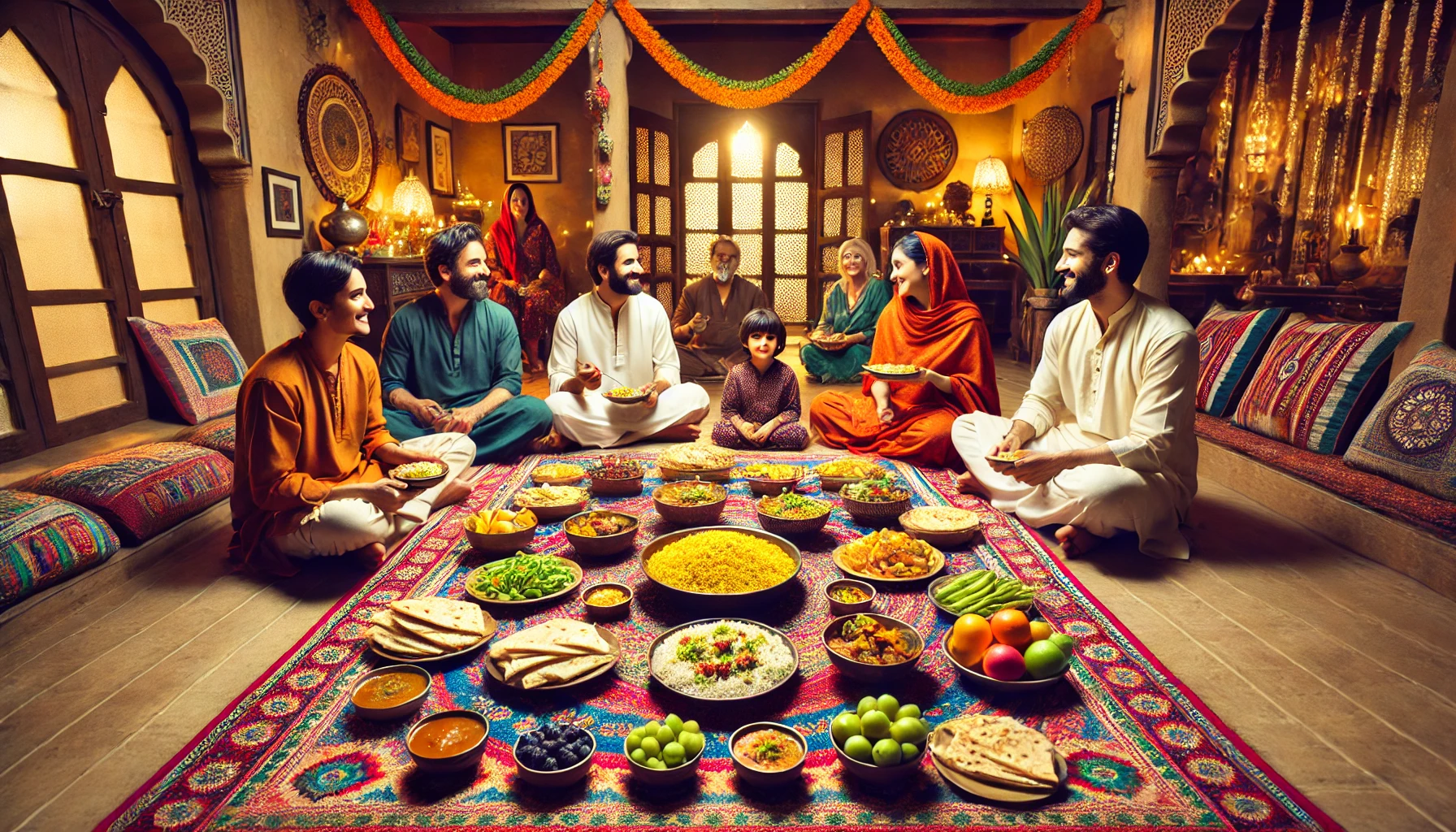If there’s one thing that unites us all, it’s food! And when that food is served on a dustakhan, the experience becomes even more special. The humble dustakhan may just be a cloth laid on the floor, but it carries centuries of culture, tradition, and hospitality, especially in South Asia. Let’s dive into the beautiful tradition of dustakhan, where everyone sits together, eats together, and builds memories that last a lifetime.
What is Dustakhan? A Simple Overview
The word dustakhan comes from Persian, where “dast” means hand and “khan” means dining spread. In essence, dustakhan is the dining cloth or spread laid on the floor where meals are served. Imagine a picnic—but indoors!
Traditionally, families sit around the dustakhan on the floor, sharing a variety of dishes. It’s not just about the food; it’s about the communal experience, sitting close to each other, and having conversations that wouldn’t happen at a formal table. it isn’t just about eating, it’s about fostering warmth, connection, and hospitality.
Dustakhan vs. Modern Dining Tables
In today’s world of sleek dining tables and cushy chairs, the dustakhan may seem a little out of place. But wait! While the dining table offers formality, it brings a sense of equality and closeness. Sitting on the floor with everyone at the same level creates a unique feeling of togetherness—something you won’t get from sitting across a table.
Plus, it has the added advantage of being portable, flexible, and perfect for large gatherings. No extra chairs needed!
Cultural Significance of Dustakhan: More Than Just a Meal
Dustakhan isn’t just about food. It represents culture, tradition, and, most importantly, hospitality. When guests are invited, laying out a dustakhan is a sign of respect. It shows that the hosts are opening not only their home but also their hearts, serving their guests with love and care.
One of the most beautiful aspects of dustakhan is its ability to bring everyone to the same level—literally! Whether you’re young or old, rich or poor, everyone sits on the floor, creating an environment of equality and humility. It doesn’t matter who you are or where you come from; when you sit down to eat on a dustakhan, you’re part of the family.
Historical Origins of Dustakhan
Dustakhan has deep historical roots, dating back to ancient Persia and the Mughal Empire. It was the Mughals who brought the tradition to the Indian subcontinent, where it has been embraced and evolved. In the palaces of the Mughals, elaborate dustakhans were laid out with lavish feasts, symbolizing royalty and grandeur.
Over time, the practice trickled down to common households. Today, the dustakhan remains a cherished tradition in many South Asian homes, a reminder of a simpler, more connected way of life.
The Mughals were known for their grandeur, and their meals were no exception. Their dustakhans were elaborate affairs, filled with delicacies and exotic dishes. However, even in these royal settings, it was a symbol of hospitality, inviting guests to share in the bounty of the empire.
How Dustakhan is Used Today
In many South Asian households, dustakhan is still a common practice, especially in rural areas. Families gather around the dustakhan, passing plates, serving each other, and engaging in heartfelt conversations. It’s an experience that brings back childhood memories for many, reminding them of their roots.
Even in urban settings, people often bring out the dustakhan for special occasions like family dinners, weddings, and religious gatherings. It’s a way of connecting with tradition, no matter how modern their surroundings may be.
Role in Religious and Spiritual Gatherings
Dustakhan plays an important role during religious gatherings, such as Iftar during Ramadan. Breaking fast together on a dustakhan creates a communal atmosphere where people connect with both their faith and their fellow diners. It’s not just a meal—it’s a spiritual experience.
Dustakhan Etiquette and Customs
When dining on a dustakhan, there are certain unwritten rules of etiquette that everyone follows. It’s all about respect, hospitality, and sharing. Here’s a quick look at some customs that come with the dustakhan:
- Serve elders first: It’s a sign of respect to offer food to the elders before serving yourself.
- Eat with your right hand: In many South Asian cultures, eating with the right hand is considered proper, while the left hand is seen as impolite.
- Share generously: The dustakhan is all about communal dining, so sharing food with others is encouraged.
A dustakhan meal isn’t just about satisfying hunger; it’s about showing respect to those around you. Whether you’re hosting guests or eating with family, the core value of dustakhan is hospitality. The food is passed around, ensuring everyone has enough, and no one leaves the meal hungry.
The Role of Food on Dustakhan
What’s on the dustakhan? Oh, just about everything delicious you can imagine! Traditionally, dustakhan meals feature home-cooked food that’s made with love. From simple daals to elaborate curries, the dustakhan offers a variety of dishes to cater to everyone’s taste.
Dustakhan really shines during special occasions. Whether it’s Eid, a wedding, or a family gathering, a dustakhan is laid out with an impressive spread. Special dishes like biryani, kebabs, and sweets are common during these celebrations. It’s not just a meal—it’s a feast!
Bridging the Gap Between Tradition and Convenience
In the hustle and bustle of modern life, some might think dustakhan has become outdated. However, many people are reviving this tradition as a way to reconnect with their cultural roots. Even in apartments and smaller homes, families are finding ways to incorporate dustakhan into their daily or weekly meals.
Believe it or not, dustakhan is making a comeback! In today’s fast-paced world, people are looking for ways to slow down and spend quality time with their loved ones. it is the perfect way to do that. It encourages togetherness and offers a break from the formal, hurried way we usually eat.
Dustakhan and Its Role in Promoting Family Bonds
One of the best things about dustakhan is how it strengthens family bonds. Sitting together on the floor, sharing stories, and laughing over a meal creates an environment where everyone feels connected. This is especially important in a world where digital distractions often keep families apart.
How to Set Up a Dustakhan: A Simple Guide
Want to try out a dustakhan at home? It’s super easy! Here’s a quick guide to get you started:
- Lay out the cloth: Spread a clean, comfortable cloth on the floor.
- Arrange the dishes: Place your food, plates, and utensils on the dustakhan.
- Sit comfortably: Gather everyone around, sitting on the floor in a circle.
- Start sharing: Serve each other and enjoy the communal meal experience!
Add a few personal touches to make your dustakhan experience memorable. Use traditional plates, light candles, or play some soothing music. The idea is to create a cozy, inviting atmosphere where everyone feels welcome.
Conclusion
The tradition of dustakhan is more than just about eating on the floor. It’s about sharing, connecting, and embracing the values of hospitality and respect. In a world that’s moving too fast, it offers us a chance to slow down, spend quality time with loved ones, and savor not just the food, but the experience itself.
So why not try it? Bring out the dustakhan, gather your family, and enjoy the timeless tradition of eating together.





